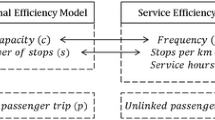Abstract
In city logistics operations, vehicle routing is critical for successful freight delivery execution. Optimal routing, however, may not be performed when manual routing methods are implemented, due to their inability to cope with a number of delivery constraints such as hard delivery time windows. The use of an automated vehicle routing software by freight carriers, is usually the preferred option, as it may increase customer service and reduce operational costs. The evaluation and selection of automated routing software has become increasingly difficult for decision makers due to a large number of software products available and the great variety of features and capabilities they offer. This paper first develops a data model to capture all the significant attributes that characterize a routing software. The attributes are measured with ordinal data as they mainly express qualitative issues. Then, it presents a data envelopment analysis (DEA) model that aids the selection procedure by estimating the index Total Performance/Price that expresses the commonly used “value for money” criterion. This index is able to identify those routing software that are considered as best buys. Moreover, this paper proposes a DEA model to distinguish the best alternative from the “best buys” cases. A case study illustrates the proposed methodology.
Similar content being viewed by others
References
Adler N, Friedman L, Sinuany-Ster Z (2002) Review of ranking methods in the data envelopment analysis context. Eur J Oper Res 140(2):249–265
Ahn H, Dyckhoff H (1997) A flexible concept for decision support: evaluation and selection of suitable product development activities. Eur J Oper Res 100(2):266–276
Ammin RG, Toloo M (2007) Finding the most efficient DMUs in DEA: an improved integrated model. Comput Ind Eng 52:71–77
Ballou RH (1999) Business logistics management. 4th International Edition©, Prentice-Hall International Inc., Upper Saddle River
Brown PA, Gibson DF (1972) A quantified model for facility site selection- application to a multiplant location problem. AIIE Tramadiad 1–10
Charnes A, Cooper WW, Rhodes E (1978) Measuring efficiency of decision making units. Eur J Oper Res 2:429–444
Cook WD, Kress M (1991) A multiple criteria decision model with ordinal preference data. Eur J Oper Res 54:191–198
Cook WD, Kress M (1994) A multiple criteria composite index model for quantitative and qualitative data. Eur J Oper Res 78:367–379
Cook WD, Zhu J (2006) Rank order data in DEA: a general framework. Eur J Oper Res 174:1021–1038
Cook WD, Kress M, Seiford LM (1993) On the use of ordinal data in data envelopment analysis. J Opl Res Soc 2(44):133–140
Cook WD, Kress M, Seiford LM (1996) data envelopment analysis in the presence of both quantitative and qualitative factors. J Oper Res Soc 47:945–953
Cordeau J-F, Desaulniers G, Desrosiers J, Solomon MM, Soumis F (2001) The vehicle routing problem with time window. In: Toth P, Vigo D (eds) The vehicle routing problem. SIAM Monographs on Discrete Mathematics and Applications, Philadelphia, pp 157–193
Despotis DK, Smirlis YG (2002) Data envelopment analysis with imprecise data. Eur J Oper Res 1(140):24–36
Dyson RG, Thanassoulis E (1988) Reducing weight flexibility in DEA. J Opl Res Soc 6(39):563–576
Fleischmann B, Gnutzmann S, Sandvob E (2002) Dynamic vehicle routing based on on-line traffic information, [Online], www.sintef.no/static/am/opti/projects/top/Publications/DynRouting17_03_03.pdf, [Accessed on 10 June 2009]
Gendreau M, Potvin JY (1998) Dynamical vehicle routing and dispatching. In: Crainic TG, Laporte G (eds) Fleet management and logistics. Kluwer, Boston, pp 115–126
Giaglis GM, Minis I, Tatarakis A, Zeimpekis V (2004) Minimizing logistics risk through real-time vehicle routing and mobile technologies: research to-date and future trends. Int J Phys Distribution Logistics Manag 34(9):749–764
Hall RW (2008) Vehicle routing software survey. OR/MS Today Magazine, http://www.lionhrtpub.com/orms/surveys/Vehicle_Routing/vrss.html
Ioannou G, Kritikos M, Prastacos G (2003) A problem generator-solver heuristic for vehicle routing with soft time windows. Omega 31:41–53
Kontio J, Chen S, Limperos K, Tesoriero R, Caldiera G, Deutsch M (1995) A COTS selection method and experiences of its use. Twentieth Annual Software Engineering Workshop, Greenbelt, Maryland
Min H, Jayaraman V, Srivastava R (1998) Combined location-routing problems: a synthesis and future research directions. Eur J Oper Res 108:1–15
Power DJ (2002) Decision support systems: concepts and resources for managers. Quorum Books, Westport
Psaraftis HN (1995) Dynamic vehicle routing: status and prospects. Ann Oper Res 611:143–164
Sarrico CS, Dyson RG (2004) Restricting virtual weights in data envelopment analysis. Eur J Oper Res 159:17–34
Seydel J (2006) Data envelopment analysis for decision support. Indust Manag Data Syst 106(1):81–95. doi:10.1108/02635570610641004
Smirlis Y, Despotis DK, Jablonsky J, Fiala P (2004) Identifying “best-buys” in the market of prepaid mobile telephony: an application of imprecise DEA. Int J Inform Decision Sci 4(2):167–177
Wang WK (2005) A knowledge-based decision support system for measuring the performance of government real estate investment. Expert Syst Appli 29(4):901–912
Zeimpekis V, Giaglis GM (2006) Urban dynamic real-time distribution services: insights from SMEs. J Enterprise Inf Manag 19(4):367–388
Zeimpekis V, Giaglis GM, Tarantilis CD, Minis I (eds) (2007a) Dynamic fleet management: concepts, systems, algorithms & case studies, operations research/computer science interfaces series, vol. 38. Springer-Verlag International, ISBN: 978-0-387-71721-0
Zeimpekis V, Tatarakis A, Giaglis GM, Minis I (2007b) Towards a dynamic real-time vehicle management system for urban distribution. Int J Integr Supply Manag 3(3):228–243
Zhu J (2003) Imprecise data envelopment analysis (IDEA): a review and improvement with an application. Eur J Oper Res 144:513–529
Author information
Authors and Affiliations
Corresponding author
Rights and permissions
About this article
Cite this article
Smirlis, Y.G., Zeimpekis, V. & Kaimakamis, G. Data envelopment analysis models to support the selection of vehicle routing software for city logistics operations. Oper Res Int J 12, 399–420 (2012). https://doi.org/10.1007/s12351-010-0100-4
Received:
Revised:
Accepted:
Published:
Issue Date:
DOI: https://doi.org/10.1007/s12351-010-0100-4




